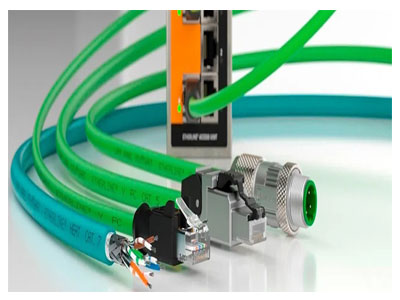Key Takeaway
Industrial Ethernet supports real-time communication through features like low latency, deterministic data transfer, and precise time synchronization. It uses protocols such as PROFINET, EtherNet/IP, and EtherCAT to ensure timely data delivery, essential for automation tasks like motion control and robotics.
Technologies like IEEE 1588 provide accurate time synchronization, ensuring all devices operate in perfect coordination. Quality of Service (QoS) prioritizes critical data, reducing delays. These capabilities make Industrial Ethernet ideal for real-time applications where precision and reliability are critical, such as manufacturing, power grids, and process control.
Key Features of Industrial Ethernet for Low Latency Communication
Low latency is essential in industrial environments where decisions must be executed without delay. Industrial Ethernet achieves this through features such as full-duplex communication, Quality of Service (QoS) mechanisms, and advanced switching technologies.
Full-duplex communication allows data to flow simultaneously in both directions, eliminating the delays caused by half-duplex systems. QoS prioritizes critical data, ensuring time-sensitive information is transmitted ahead of less urgent traffic. Advanced switching reduces the time packets spend traversing the network by optimizing data paths.
For instance, in a robotic assembly line, low latency ensures that commands from the controller reach the robots instantly, preventing misalignments or delays. Without such speed, the entire production process could suffer.
Understanding these features helps engineers design networks that meet the high-speed requirements of modern industry, ensuring smooth and reliable operations.

Real-Time Communication Protocols in Industrial Ethernet
Protocols are the backbone of real-time communication in Industrial Ethernet. Protocols like PROFINET, EtherNet/IP, and EtherCAT are specifically designed to handle the demands of industrial applications.
PROFINET excels in time-critical environments, offering real-time and isochronous modes for deterministic communication. EtherNet/IP uses CIP Sync and CIP Motion for real-time control in automation systems, ensuring devices stay synchronized. EtherCAT takes efficiency further by processing data on the fly, making it ideal for high-speed, high-precision applications like CNC machines or semiconductor manufacturing.
These protocols are what enable Industrial Ethernet to meet diverse real-time requirements. For example, EtherCAT’s on-the-fly data processing ensures rapid feedback in a packaging line, where split-second adjustments are necessary to maintain quality and throughput.
By mastering these protocols, engineers can implement solutions that balance speed, precision, and flexibility, making them invaluable assets in any industrial setup.
Ensuring Deterministic Data TransmissionWith Industrial Ethernet
Ensuring Deterministic Data TransmissionWith Industrial Ethernet
How Industrial Ethernet Handles Time-Sensitive Applications
Time-sensitive applications require networks to deliver data with ultra-low latency and high reliability. Industrial Ethernet meets these demands with specialized enhancements like Time-Sensitive Networking (TSN) and advanced traffic management techniques.
TSN extends Ethernet’s capabilities by introducing features like frame preemption and scheduled traffic. Frame preemption allows high-priority data to interrupt lower-priority traffic, ensuring critical messages are delivered without delay. Scheduled traffic ensures data is transmitted at precise intervals, critical for applications like synchronized robotics or real-time monitoring systems.
An example of this is in autonomous vehicle production, where multiple robots work together on the same chassis. TSN ensures that commands are executed in perfect harmony, enabling precise movements and seamless coordination.
For engineers, leveraging Industrial Ethernet’s time-sensitive capabilities allows them to design systems that meet the tightest performance requirements, ensuring reliability even in the most demanding environments.
Applications Requiring Real-Time Communication in Industrial Networks
Real-time communication is indispensable in many industrial applications. These include robotics, motion control, power grid management, and real-time monitoring systems. Each application has unique requirements, but all share a need for fast, reliable data exchange.
In robotics, real-time communication ensures that movements are synchronized and precise, preventing errors that could disrupt production. Motion control systems rely on deterministic data transmission to coordinate multiple axes in CNC machines, ensuring flawless cuts and designs.
Power grids use real-time communication to monitor and manage energy distribution, responding instantly to changes in demand or supply. Monitoring systems, such as those in oil refineries, depend on real-time data to identify and address issues before they escalate.
For engineers, understanding these applications highlights the importance of Industrial Ethernet in driving efficiency, safety, and innovation across industries. It also emphasizes the need to select the right protocols and configurations for specific operational needs.
Conclusion
Industrial Ethernet has become the go-to solution for real-time communication, offering features like low latency, deterministic data transfer, and time-sensitive capabilities. Its ability to support diverse protocols and applications makes it a versatile and reliable choice for industries ranging from manufacturing to energy.
As an engineer, understanding how Industrial Ethernet meets these challenges equips you to design and maintain systems that deliver precision, efficiency, and reliability. By mastering its features, you’ll contribute to building networks that keep industries running smoothly in an increasingly interconnected world.
